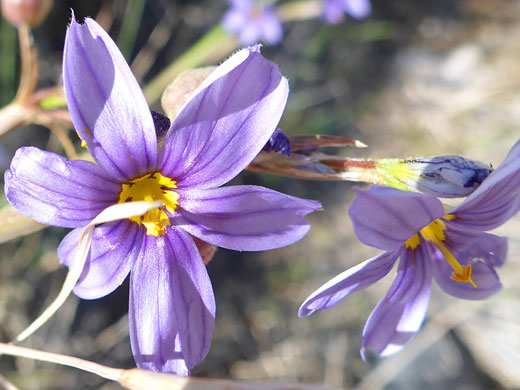Sisyrinchium Funereum, Death Valley Blue-Eyed Grass
Plants > Wildflowers > Iridaceae > Sisyrinchium Funereum

Six pale purple petals; sisyrinchium funereum, Grapevine Springs, Death Valley National Park, California
Common name:
Death Valley blue-eyed grass
Family:
Scientific name:
Sisyrinchium funereum
Main flower color:
Range:
Death Valley in California, and adjoining areas of Nevada
Height:
Up to 30 inches
Habitat:
Wet, alkaline places; streambanks, springs and seeps, from sea level to 2,500 feet
Leaves:
Narrow, linear, up to 15 inches long
Season:
February to April
Sisyrinchium funereum is a rare, localized species, found only in Death Valley, Ash Meadows NWR and some adjacent areas. Stem and leaves are grey-green in color, with a glaucous coating, and plants usually have two or three branches, attached at a single point, which can be either low or high along the main stem. Flowers are produced singly at the top of the branches, and are subtended by a pair of purplish-green bracts, or spathes, two or three times as wide as the stem. The outer spathe is up to 1 inch in length, generally slightly longer and wider than the inner spathe. The outer spathe is fused at the base, forming a sheath. Spathes have narrow, transparent margins.
Flowers consist of six bluish-purple tepals, yellow at the base, crossed by darker purple veins, and up to 0.6 inches long. Tepal tips are somewhat flattened, with a small point in the middle. At the center of the flower is a fused group of yellow styles and stamens.
Flowers consist of six bluish-purple tepals, yellow at the base, crossed by darker purple veins, and up to 0.6 inches long. Tepal tips are somewhat flattened, with a small point in the middle. At the center of the flower is a fused group of yellow styles and stamens.
All Contents © Copyright The American Southwest | Comments and Questions | Contribute | Site Map



